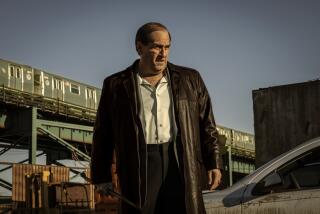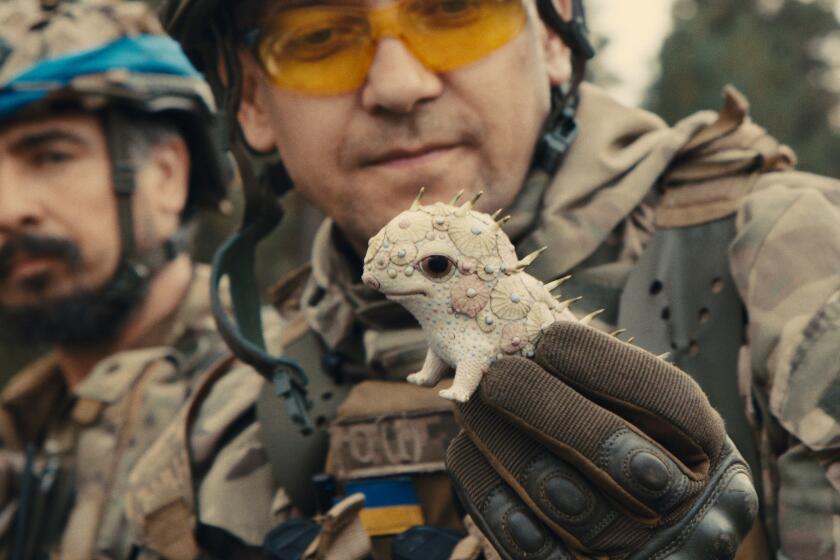Review: Terry Gilliam’s ‘The Man Who Killed Don Quixote,’ at long last, loses its way
- Share via
I have approached few recent films with the same anxious trepidation as I did “The Man Who Killed Don Quixote.” Through some 25 years in the making, through production starts and stops, rewrites, deaths, cast changes, financing hassles, bad weather — enough fodder for a 2002 documentary, “Lost in La Mancha,” on the collapse of one iteration of the movie — most filmmakers would have eventually taken the hint and moved on. But Terry Gilliam is not most filmmakers.
From his time as part of the Monty Python comedy troupe on to directing films such as “Time Bandits,” “Brazil,” “The Fisher King” and “Fear and Loathing in Las Vegas,” Gilliam has explored the grotesque and the absurd in the human condition, with a particular attention to the flights of fancy we tell ourselves to make the world bearable in its darkest moments and the freedom to be found within the imagination. So the idea that he would become fixated on the “Don Quixote” story, that of a man who lives in a fantasy world of his own making, makes its own sort of sense.
Working with co-writer Tony Grisoni, Gilliam’s take on “Quixote” has changed over the years, landing on the tale of a successful director of commercials who is feeling artistically unfulfilled. One night the director, Toby (Adam Driver), comes across a bootleg copy of his old student film sold by a gypsy. The little village in Spain where he shot it is not far from where he is currently working and a return trip brings some unsettling discoveries. The young woman (Joana Ribeiro) he thought could be a star has fallen into a rough life as an escort to a treacherous businessman, and the old shoemaker he cast as his Quixote (Pryce) now suffers from delusions that his role was real. Toby soon finds himself doubting what he sees, as the line between reality and the imaginary becomes increasingly convoluted.
The notion of men falling into a delusion is something of a through-line in Gilliam’s work. Yet it’s hard to see that he has actually learned much after telling variations of this story again and again, and “The Man Who Killed Don Quixote” feels only surface-level deep. Hooray for creativity and the idea of an authentic self and all that, but that has come to seem too unexamined and easy of a position to take. Thinking how different the world feels from even five years ago, let alone 25, the movie feels at a remove, not so much dated as just distanced, needlessly off on its own.
The natural reading of the film is that Gilliam has become Quixote, lost in his own mind, yet the filmmaker has insisted that he sees himself as the character of Sancho Panza, faithful servant to the story. Which may explain why within Gilliam’s ultimate telling of the tale, Driver’s character of Toby is put into the role of Panza to Pryce’s Quixote. At least at first.
Working in a much broader range than he often has on-screen, Driver uses his full, long-limbed body to angularly depict a comic-strip caricature come to life, with a twitchy, pulsing anxiety. As Toby’s grasp on reality becomes more tenuous, Driver becomes more manic and less composed. Pryce brings a deep sympathetic feeling to his portrayal of a man going through his own emotional struggles.
The film’s editing, overseen by Gilliam’s frequent collaborator Lesley Walker, often feels choppy as if simply trying to make the best of what they ended up with. The camerawork by Nicola Pecorini, another close Gilliam collaborator, makes the most of the film’s locations in Spain, Portugal and the Canary Islands to evocative effect.
The film at times recalls the energy of the run-and-gun films Orson Welles made in Europe during the 1950s and ’60s, like “Mr. Arkadin” or “Chimes at Midnight,” and ultimately brings to mind Welles’ own troubled opus, “The Other Side of the Wind,” finished posthumously. If there’s an upside to Gilliam’s long saga with “Don Quixote,” it’s that the film indeed is now finished and is still unmistakably his.
And so while Gilliam has undoubtedly made better films and certainly greater films than “The Man Who Killed Don Quixote,” there is something about the ridiculous effort and mixed results that make this arguably the most Gilliam-esque. For anyone struggling with whether to give up, concerned that the result will not match the effort, Gilliam seems to be planting a flag — or more accurately charging a windmill — to say the effort is the reward.
------------
‘The Man Who Killed Don Quixote’
Not rated
Running time: 2 hours, 12 minutes
Playing: April 10, Fathom Events theaters across Southern California
SIGN UP for the free Indie Focus movies newsletter »
Follow on Twitter: @IndieFocus
More to Read
Only good movies
Get the Indie Focus newsletter, Mark Olsen's weekly guide to the world of cinema.
You may occasionally receive promotional content from the Los Angeles Times.











